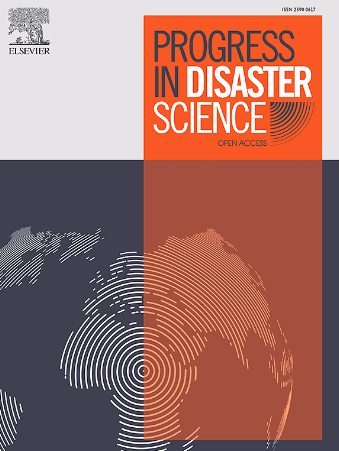On moving towards a more inclusive understanding of disaster risk reduction: A sexual and gender minorities perspective through the lens of global flood risk
IF 3.8
Q3 ENVIRONMENTAL SCIENCES
引用次数: 0
Abstract
Considering social vulnerability of marginalized communities is crucial for equitable disaster risk reduction. This paper emphasizes the need to include sexual and gender minorities in global vulnerability assessments and policymaking. This community faces unique challenges in disasters, often overlooked in disaster risk reduction strategies and agendas. While natural hazards do not discriminate, societal ideologies and laws can, amplifying disparate outcomes. Our flood risk analysis reveals that over one-third of the global expected annual affected population – 26.5 to 33.9 million people – live in countries lacking legal protections for sexual and gender minorities. Future scenarios indicate this could double to 58.6 to 73.1 million by 2050. Meanwhile, two-thirds of those at risk to floods reside in countries with below-average societal acceptance of sexual and gender minorities, increasing their vulnerability before, during and after flooding disasters. To address these disparities, global frameworks must urgently integrate specific metrics into social vulnerability assessments and risk planning. Including marginalized communities ensures that disaster risk reduction efforts are more responsive and effective. By acknowledging the intersection of societal acceptance, legal protections, and disaster risk, we can advance more inclusive and impactful strategies to mitigate the growing impacts of climate-fuelled hazards like coastal and riverine flooding.
关于对减少灾害风险有更包容的理解:从全球洪水风险的角度看性和性别少数群体的观点
考虑边缘化社区的社会脆弱性对于公平地减少灾害风险至关重要。本文强调了在全球脆弱性评估和政策制定中纳入性和性别少数群体的必要性。这个群体在灾害中面临着独特的挑战,而这些挑战在减少灾害风险的战略和议程中往往被忽视。虽然自然灾害不会造成歧视,但社会意识形态和法律会造成歧视,从而放大不同的后果。我们的洪水风险分析显示,全球预计每年受影响人口的三分之一以上(2650万至3390万人)生活在缺乏对性少数群体和性别少数群体的法律保护的国家。未来的情景表明,到2050年,这一数字可能会翻一番,达到5860万至7310万。与此同时,三分之二面临洪水风险的人居住在社会对性和性别少数群体的接受程度低于平均水平的国家,这增加了他们在洪水灾害发生之前、期间和之后的脆弱性。为了解决这些差异,全球框架必须紧急将具体指标纳入社会脆弱性评估和风险规划。包括边缘化社区,可确保减少灾害风险的努力更具响应性和有效性。通过认识到社会接受度、法律保护和灾害风险之间的相互作用,我们可以推进更具包容性和影响力的战略,以减轻沿海和河流洪水等气候引发的灾害日益严重的影响。
本文章由计算机程序翻译,如有差异,请以英文原文为准。
求助全文
约1分钟内获得全文
求助全文
来源期刊

Progress in Disaster Science
Social Sciences-Safety Research
CiteScore
14.60
自引率
3.20%
发文量
51
审稿时长
12 weeks
期刊介绍:
Progress in Disaster Science is a Gold Open Access journal focusing on integrating research and policy in disaster research, and publishes original research papers and invited viewpoint articles on disaster risk reduction; response; emergency management and recovery.
A key part of the Journal's Publication output will see key experts invited to assess and comment on the current trends in disaster research, as well as highlight key papers.
 求助内容:
求助内容: 应助结果提醒方式:
应助结果提醒方式:


